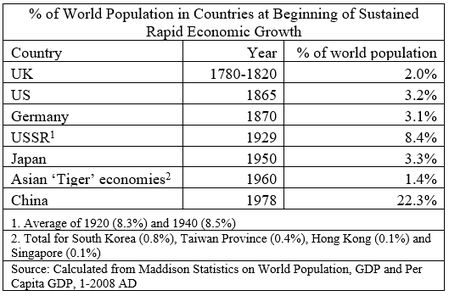Blog | Economic Development | 02 Jun 2018
China’s socialist ‘reform and opening up’ improved the lives of a greater proportion of humanity than any other country in human history

An earlier article in this series marking the 40th anniversary of China’s ‘Reform and Opening Up’ showed that China since 1978 is the fastest sustained growth by a major economy in human history. But this historic fact, although extraordinary in its own right, actually considerably understates the immense scale of China’s achievement. The reason for this is that China is such a larger part of humanity than any other country which has ever undergone sustained very rapid economic growth – with the enormous improvement in living standards this produces.
To demonstrate this the chart and the table below show the percentage of the world’s population at the time when major economies began sustained rapid economic growth. Analysing these historical examples:
- The first country to experience sustained rapid economic growth was the UK in the Industrial Revolution, with 2.0% of the world’s population. Economic historians differ over when this exactly began in 1780-1820 but this makes no significant difference to the figure.
- Sustained rapid US economic growth, after its Civil War, was in a country with 3.2% of the world’s population.
- When Soviet rapid industrialisation began at the end of the 1920s the USSR contained 8.4% of the world’s population. From this it can be seen why the USSR made such a huge international impact, as its population was almost three times that of any other country which had ever undergone rapid growth.
- Japan’s rapid post-World War II growth was in a country with 3.3% of the world’s people.
- The growth of the four ‘Asian Tigers’ (Hong Kong, Singapore, South Korea, and Taiwan Province of China) was in economies which together only comprised 1.4% of the world’s population.
- No other economy commencing sustained rapid economic growth therefore even remotely approaches the 22.3% of the world’s population in China in 1978 at the beginning of its economic reform. China’s, at the time of the beginning of ‘reform and opening up’, was seven times the relative percentage of the world population of the US or Japan, and almost three times that of the USSR.
Additional countries might be included – for example Italy from 1950 (1.9% of the world’s population) or Spain from 1960 (1.0% of the world’s population) – but introducing these clearly makes absolutely no significant difference.
Although both the rapidity and scale of China’s economic achievement since the beginning of its socialist ‘reform and opening up’ in 1978 dwarfs any other economic growth in human history even this is not its most important achievement. Most important is the improvement in the lives of ordinary Chinese people. As will be shown in later articles this produced the most rapid increase in living standards of the greatest number of people in human history and mean China accounted for a greater reduction of the number of those living in poverty than the rest of the world put together. These issues will be analysed in future articles in this series.
But there is a fundamental reason that the ‘Western media’ has to suppress knowledge of the fact that China’s growth dwarfs that of any previous country in human history. It is because this unmatched speed and scale of China’s economic development was achieved by a socialist and not by a capitalist country and economy. If that fact were widely understood it would change the world’s perception of itself. Therefore the ‘Western media’ has to engage in one of its typical forms of ‘fake news’ – to suppress knowledge of the fact that China’s economic achievement is quite literally without parallel in human history.



